人教新课标必修4 Unit4 Body language warming up and reading课件 (共35张PPT)
文档属性
| 名称 | 人教新课标必修4 Unit4 Body language warming up and reading课件 (共35张PPT) | 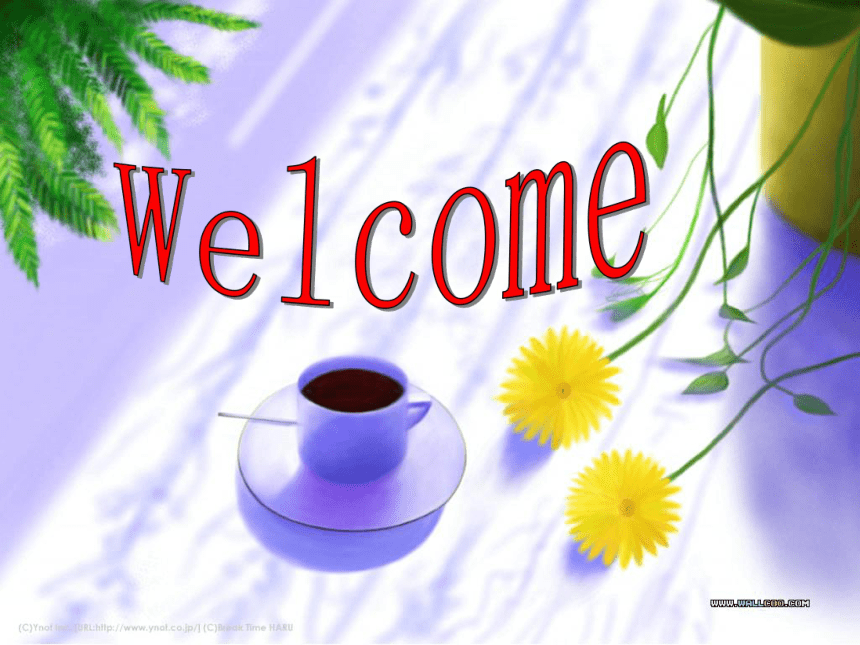 | |
| 格式 | zip | ||
| 文件大小 | 4.4MB | ||
| 资源类型 | 教案 | ||
| 版本资源 | 人教版(新课程标准) | ||
| 科目 | 英语 | ||
| 更新时间 | 2021-01-06 21:16:36 | ||
图片预览

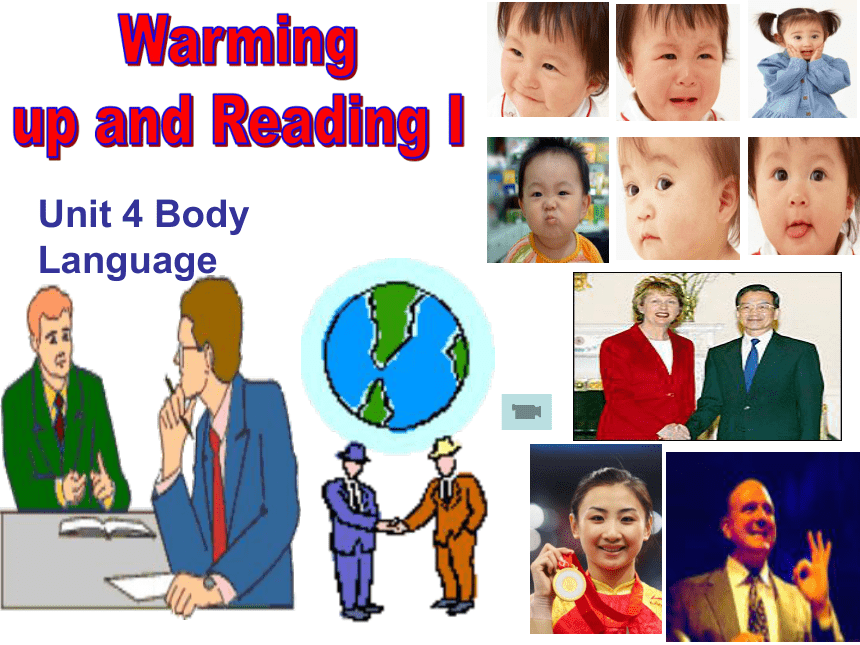
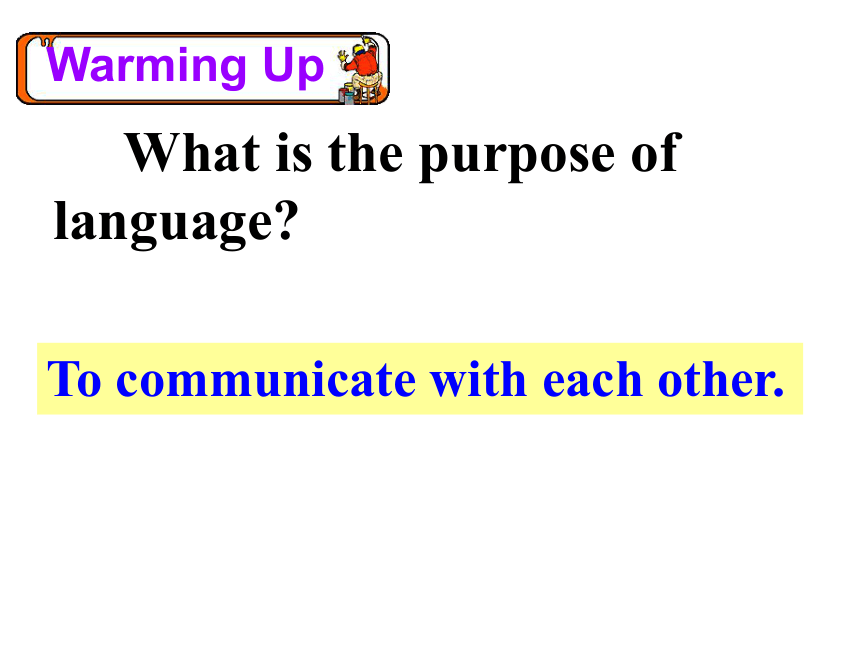
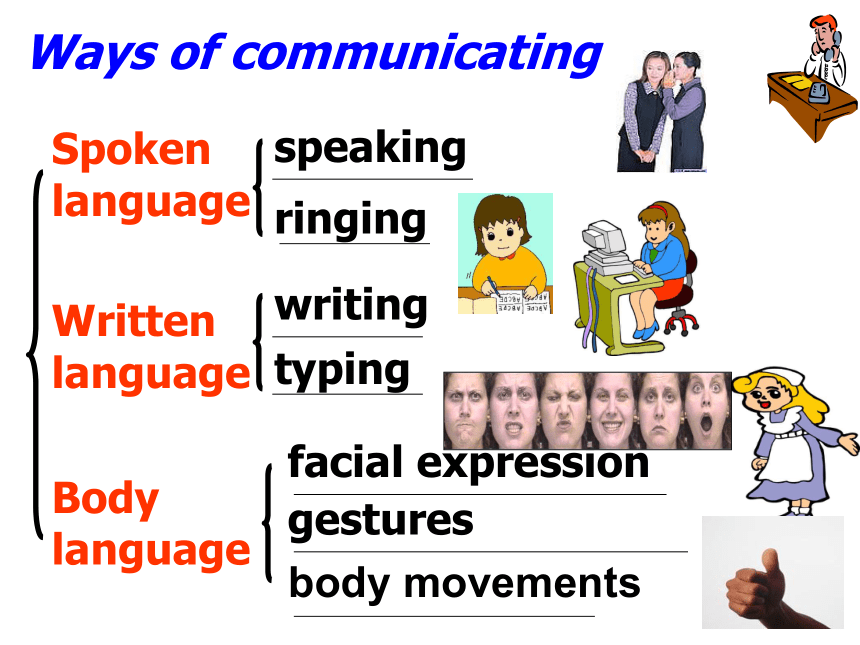
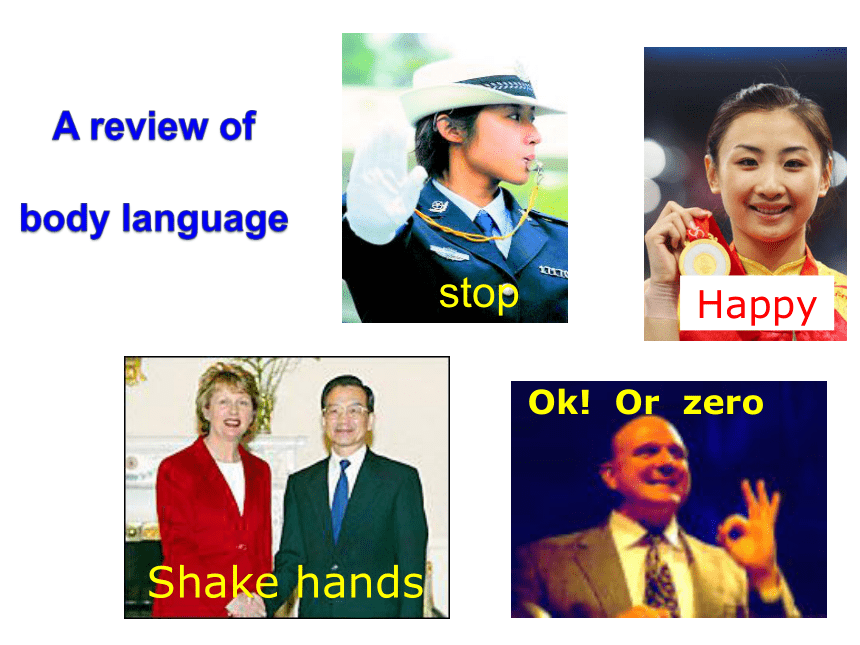
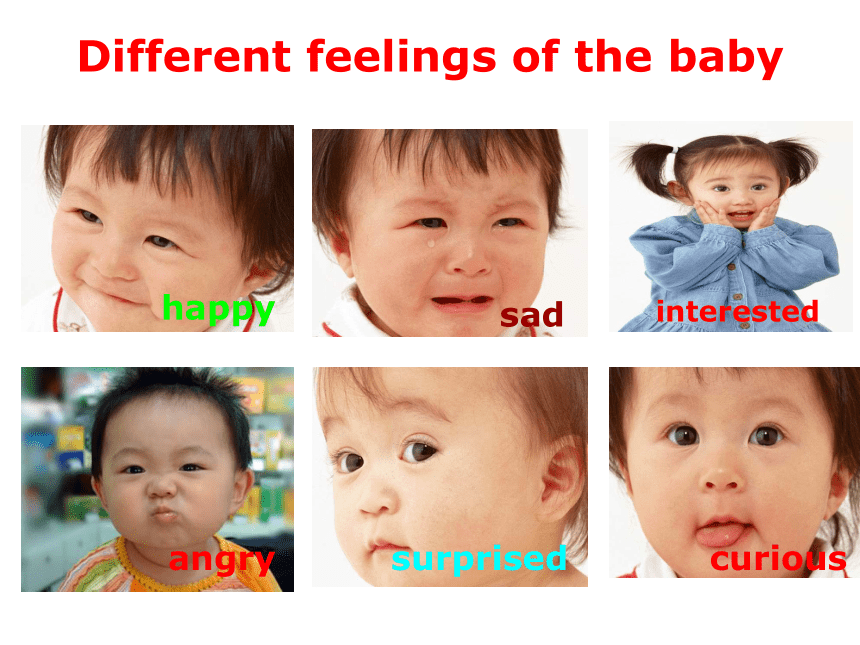
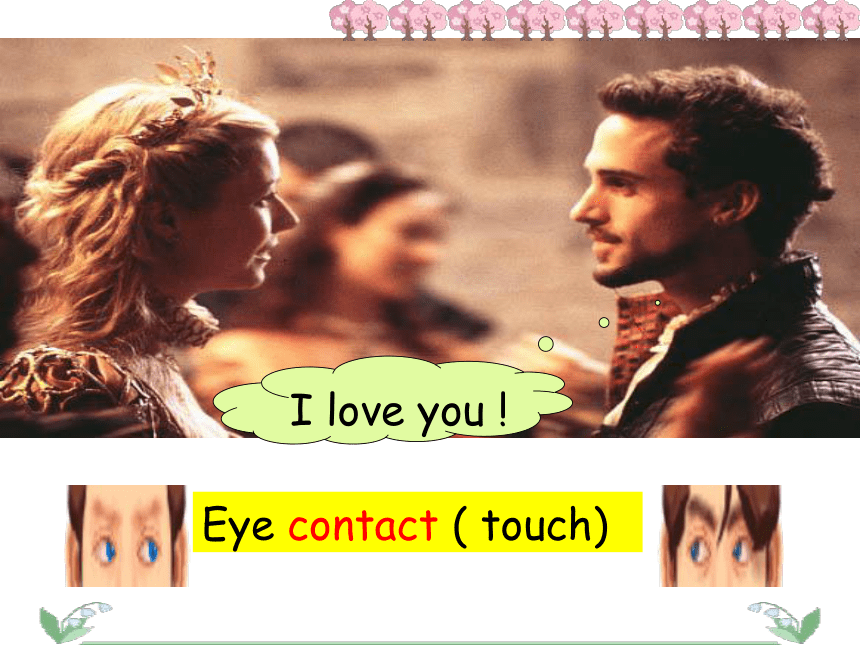
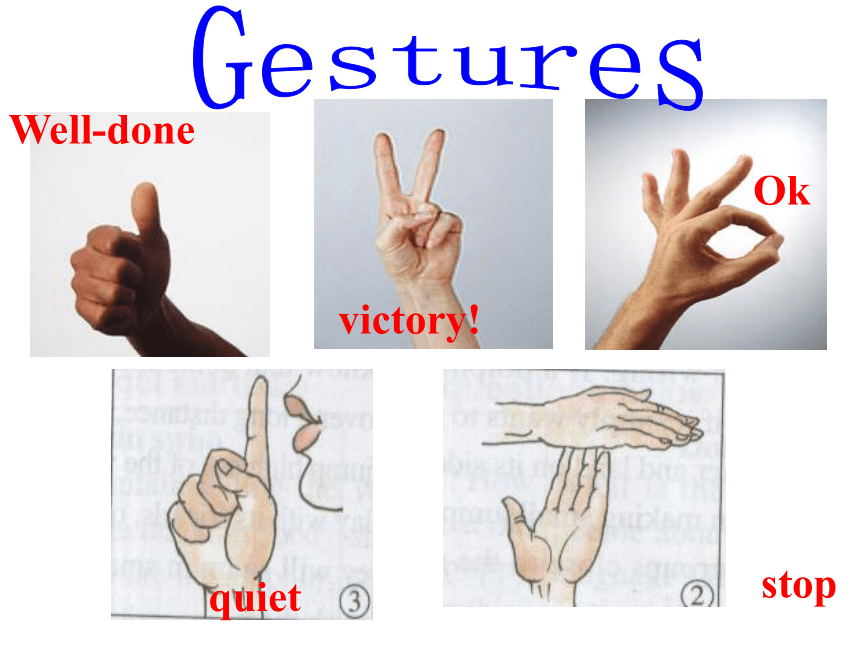

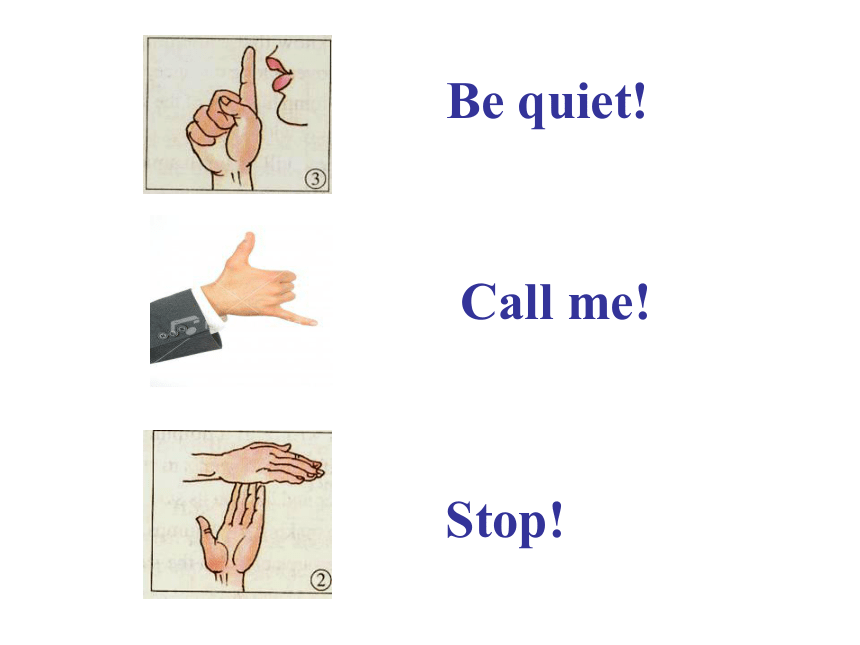

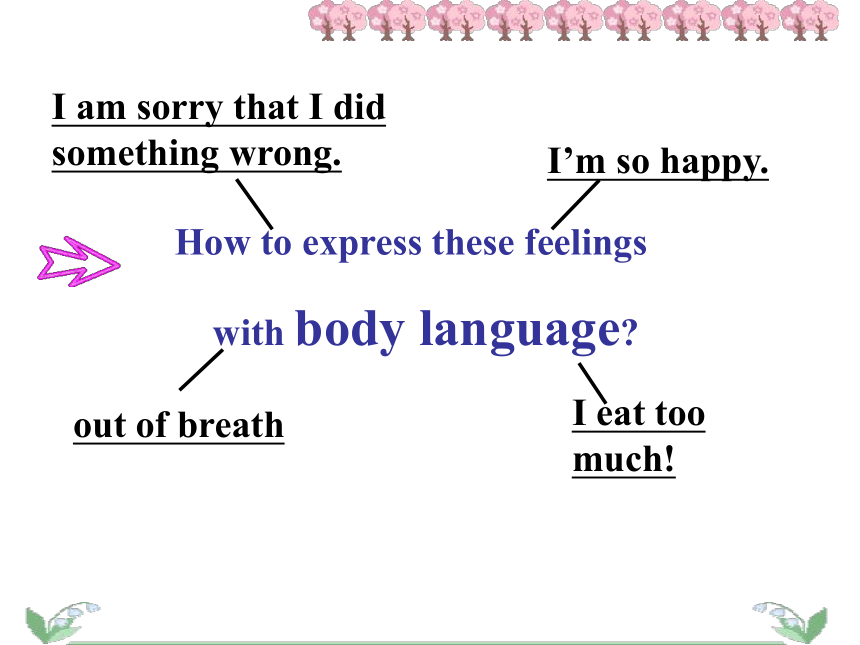
文档简介
(共35张PPT)
Unit
4
Body
Language
Warming
Up
What
is
the
purpose
of
language?
To
communicate
with
each
other.
speaking
ringing
writing
typing
Spoken
language
Written
language
Body
language
Ways
of
communicating
gestures
facial
expression
body
movements
stop
Shake
hands
Happy
Ok!
Or
zero
Different
feelings
of
the
baby
happy
sad
interested
angry
surprised
curious
Eye
contact
(
touch)
I
love
you
!
Well-done
Ok
stop
quiet
victory!
Victory/win!
I
love
you!
Ok!
Be
quiet!
Call
me!
Stop!
I
don’t
know
How
to
express
these
feelings
with
body
language?
I
eat
too
much!
I
am
sorry
that
I
did
something
wrong.
I’m
so
happy.
out
of
breath
Let’s
do
a
quiz.
inspired/disappointed
regretful/excited
confident/confused
confused
inspired
regretful
surprised
astonished
shy
happy
Do
you
know
the
meaning
of
the
following
facial
expressions
?
Body
Language
is
a
set
of
__________,
_______________
and
____________
.
people
use
to
make
themselves
understood.
What
is
body
language
?
gestures
body
movements
facial
expressions
Different
ways
to
meet
or
part
handshake
a
loving
hug
a
kiss
on
the
cheek
nose-
kiss
two
palms
together
bowing
COMMUNICATION:
NO
PROBLEM?
Reading
In
Russia,
France
and
Arab
countries
men
kiss
each
other.
When
people
meet
each
other…
In
China,
people
shake
hands.
When
people
meet
each
other…
In
Japan,
women
bow.
When
people
meet
each
other…
In
Arab
countries,
you
should
eat
with
your
right
hand
not
the
left
hand.
Is
there
anything
wrong
in
the
pictures?
Is
there
anything
wrong
in
the
pictures?
In
parts
of
Asia
you
must
not
sit
with
your
feet
pointing
at
another
person.
Look
at
the
title
and
picture
on
page
26
and
predict
what
the
passage
is
about.
Which
is
the
main
idea
of
the
text?
A.
There
are
different
customs
in
different
countries.
B.
Foreigners
should
follow
the
customs
of
the
country
where
they
are
visiting.
C.
People
use
body
movements
to
send
messages
and
different
body
movements
have
different
meanings.
D.
The
importance
of
knowing
customs.
(Para.1)
(Para.
2~3)
(Para.
4)
(Para.
5)
Different
people
have
different
body
language.
Meet
the
visitors
at
the
airport.
Summary
of
body
language.
Match
the
main
idea
of
each
part
with
lines.
Part
1.
Part
2.
Part
3.
Part
4.
People
from
different
countries
express
greetings
in
different
ways.
1
.
Who
will
be
present
at
the
meeting?
2
.
Why
are
people
visiting
China?
Careful
reading
:
Part
1
people
present
purpose
businessmen
from
foreign
countries
local
businessmen
people
who
represent
the
Chinese
government
interested
meet
Mr.
Garcia
(Columbia)
Julia
Smith
(Britain)
Visitor
(Japan)
George
Cook
(Canada)
Madame
Coulon
(France)
Matching
the
people
and
the
different
ways
of
greeting
(para2&5)
shakes
hands
and
kisses
others
twice
on
each
cheek
Bows
shakes
hands
approaches
others
closely
and
touches
their
shoulder
and
kisses
them
on
the
cheek
does
not
stand
very
close
to
others
or
touch
strangers
Mr.
Garcia
(Columbia)
Julia
Smith
(Britain)
Visitor
(Japan)
George
Cook
(Canada)
Mr
Garcia
(Columbia)
Julia
Smith
(Britain)
Visitor
(Japan)
George
Cook
(Canada)
Madame
Coulon
(France)
Matching
the
people
and
their
different
ways
of
greeting
(para2&3)
shakes
hands
and
kisses
others
twice
on
each
cheek
bows
shakes
hands
approaches
others
closely
and
touches
their
shoulder
and
kisses
them
on
the
cheek
does
not
stand
very
close
to
others
or
touch
strangers
Part
2
Find
out
the
two
mistakes
the
author
found
in
the
airport:
Mr.
Garcia
Julia
Smith
The
first
mistake
(from
Columbia)
(from
Britain)
He
approaches
Ms
Smith
by
_______
______
_________
and
_______
her
on
the
________.
She
______
________
appearing
_________
and
take
a
few
steps
_______
______
Mr.
Garcia.
shoulder
touching
her
kissed
cheek
stepped
back
surprised
away
from
Para
2
The
second
mistake
a
Japanese
George
Cook
(from
Canada)
He
________
________
_______
________
to
the
Japanese.
He
________
to
Mr.
Cook
and
his
nose
_________
Mr.
Cook’s
_______
________.
bowed
touched
moving
hand
reached
his
hand
out
Body
language
is
very
important
in
our
daily
life,
and
it
may
vary
from
different
cultures.
When
we
are
visiting
other
countries,
we
should
follow
their
customs.
That
is
to
say,
_________________________.
What
can
you
learn
from
this
passage?
Homework:
1.
Recite
the
new
words
in
the
text.
2.
Go
over
“Learning
about
language”
1.
2.
And
3
on
P27-28.
Unit
4
Body
Language
Warming
Up
What
is
the
purpose
of
language?
To
communicate
with
each
other.
speaking
ringing
writing
typing
Spoken
language
Written
language
Body
language
Ways
of
communicating
gestures
facial
expression
body
movements
stop
Shake
hands
Happy
Ok!
Or
zero
Different
feelings
of
the
baby
happy
sad
interested
angry
surprised
curious
Eye
contact
(
touch)
I
love
you
!
Well-done
Ok
stop
quiet
victory!
Victory/win!
I
love
you!
Ok!
Be
quiet!
Call
me!
Stop!
I
don’t
know
How
to
express
these
feelings
with
body
language?
I
eat
too
much!
I
am
sorry
that
I
did
something
wrong.
I’m
so
happy.
out
of
breath
Let’s
do
a
quiz.
inspired/disappointed
regretful/excited
confident/confused
confused
inspired
regretful
surprised
astonished
shy
happy
Do
you
know
the
meaning
of
the
following
facial
expressions
?
Body
Language
is
a
set
of
__________,
_______________
and
____________
.
people
use
to
make
themselves
understood.
What
is
body
language
?
gestures
body
movements
facial
expressions
Different
ways
to
meet
or
part
handshake
a
loving
hug
a
kiss
on
the
cheek
nose-
kiss
two
palms
together
bowing
COMMUNICATION:
NO
PROBLEM?
Reading
In
Russia,
France
and
Arab
countries
men
kiss
each
other.
When
people
meet
each
other…
In
China,
people
shake
hands.
When
people
meet
each
other…
In
Japan,
women
bow.
When
people
meet
each
other…
In
Arab
countries,
you
should
eat
with
your
right
hand
not
the
left
hand.
Is
there
anything
wrong
in
the
pictures?
Is
there
anything
wrong
in
the
pictures?
In
parts
of
Asia
you
must
not
sit
with
your
feet
pointing
at
another
person.
Look
at
the
title
and
picture
on
page
26
and
predict
what
the
passage
is
about.
Which
is
the
main
idea
of
the
text?
A.
There
are
different
customs
in
different
countries.
B.
Foreigners
should
follow
the
customs
of
the
country
where
they
are
visiting.
C.
People
use
body
movements
to
send
messages
and
different
body
movements
have
different
meanings.
D.
The
importance
of
knowing
customs.
(Para.1)
(Para.
2~3)
(Para.
4)
(Para.
5)
Different
people
have
different
body
language.
Meet
the
visitors
at
the
airport.
Summary
of
body
language.
Match
the
main
idea
of
each
part
with
lines.
Part
1.
Part
2.
Part
3.
Part
4.
People
from
different
countries
express
greetings
in
different
ways.
1
.
Who
will
be
present
at
the
meeting?
2
.
Why
are
people
visiting
China?
Careful
reading
:
Part
1
people
present
purpose
businessmen
from
foreign
countries
local
businessmen
people
who
represent
the
Chinese
government
interested
meet
Mr.
Garcia
(Columbia)
Julia
Smith
(Britain)
Visitor
(Japan)
George
Cook
(Canada)
Madame
Coulon
(France)
Matching
the
people
and
the
different
ways
of
greeting
(para2&5)
shakes
hands
and
kisses
others
twice
on
each
cheek
Bows
shakes
hands
approaches
others
closely
and
touches
their
shoulder
and
kisses
them
on
the
cheek
does
not
stand
very
close
to
others
or
touch
strangers
Mr.
Garcia
(Columbia)
Julia
Smith
(Britain)
Visitor
(Japan)
George
Cook
(Canada)
Mr
Garcia
(Columbia)
Julia
Smith
(Britain)
Visitor
(Japan)
George
Cook
(Canada)
Madame
Coulon
(France)
Matching
the
people
and
their
different
ways
of
greeting
(para2&3)
shakes
hands
and
kisses
others
twice
on
each
cheek
bows
shakes
hands
approaches
others
closely
and
touches
their
shoulder
and
kisses
them
on
the
cheek
does
not
stand
very
close
to
others
or
touch
strangers
Part
2
Find
out
the
two
mistakes
the
author
found
in
the
airport:
Mr.
Garcia
Julia
Smith
The
first
mistake
(from
Columbia)
(from
Britain)
He
approaches
Ms
Smith
by
_______
______
_________
and
_______
her
on
the
________.
She
______
________
appearing
_________
and
take
a
few
steps
_______
______
Mr.
Garcia.
shoulder
touching
her
kissed
cheek
stepped
back
surprised
away
from
Para
2
The
second
mistake
a
Japanese
George
Cook
(from
Canada)
He
________
________
_______
________
to
the
Japanese.
He
________
to
Mr.
Cook
and
his
nose
_________
Mr.
Cook’s
_______
________.
bowed
touched
moving
hand
reached
his
hand
out
Body
language
is
very
important
in
our
daily
life,
and
it
may
vary
from
different
cultures.
When
we
are
visiting
other
countries,
we
should
follow
their
customs.
That
is
to
say,
_________________________.
What
can
you
learn
from
this
passage?
Homework:
1.
Recite
the
new
words
in
the
text.
2.
Go
over
“Learning
about
language”
1.
2.
And
3
on
P27-28.
同课章节目录
